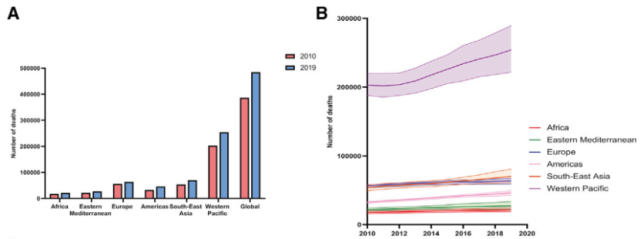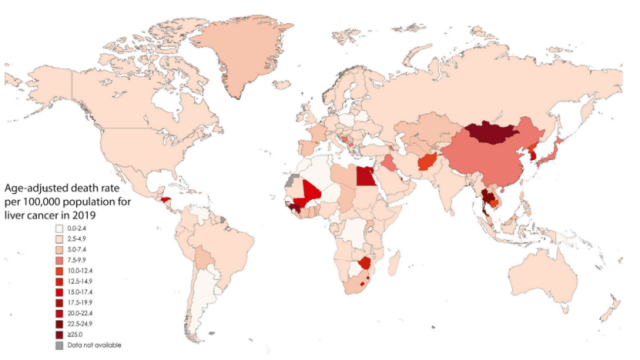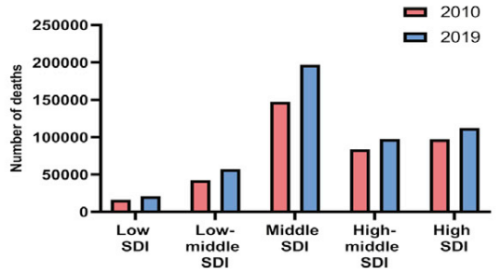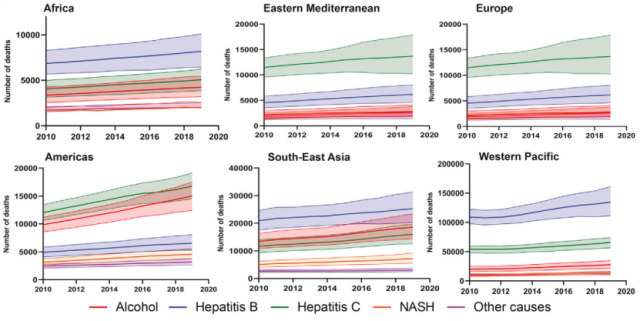Cell Metabolism: The latest data on global liver cancer is released
- Normal Liver Cells Found to Promote Cancer Metastasis to the Liver
- Nearly 80% Complete Remission: Breakthrough in ADC Anti-Tumor Treatment
- Vaccination Against Common Diseases May Prevent Dementia!
- New Alzheimer’s Disease (AD) Diagnosis and Staging Criteria
- Breakthrough in Alzheimer’s Disease: New Nasal Spray Halts Cognitive Decline by Targeting Toxic Protein
- Can the Tap Water at the Paris Olympics be Drunk Directly?
Cell Metabolism: The latest data on global liver cancer is released
- Should China be held legally responsible for the US’s $18 trillion COVID losses?
- CT Radiation Exposure Linked to Blood Cancer in Children and Adolescents
- FDA has mandated a top-level black box warning for all marketed CAR-T therapies
- Can people with high blood pressure eat peanuts?
- What is the difference between dopamine and dobutamine?
- How long can the patient live after heart stent surgery?
“Cell Metabolism”: The latest data on global liver cancer is released, and a new carcinogen is on the rise!
Globally, liver cancer ranks third in cancer mortality [1]. The major causes of liver cancer include hepatitis B, hepatitis C, alcohol, and nonalcoholic steatohepatitis (NASH) [2]. The burden and etiology of liver cancer has changed over the past decade [3].
According to the latest global cancer burden data in 2020 released by the International Agency for Research on Cancer of the World Health Organization [1].
The main causes of liver cancer in some countries include hepatitis B, hepatitis C, alcohol, NASH, aflatoxin and aristolochic acid.
With the widespread vaccination of hepatitis B vaccine and the widespread use of antiviral therapy, the burden of hepatitis B virus-related liver cancer worldwide has declined. Since the launch of the oral anti-HCV drug sofosbuvir tablets in 2013, the risk of hepatitis C-related liver cancer has also been significantly reduced [4].
Although the burden of virus-related liver cancer has declined, economic and social development has contributed to the “wind of drinking” and increased the burden of alcoholic liver cancer.
In addition, the prevalence of NASH in the United States, Europe, and Asia has also risen in tandem with obesity and diabetes, resulting in a marked increase in the incidence of NASH-related liver cancer, however, the latest global-scale statistics are still lacking.
Recently, a research team led by Rohit Loomba of the University of California, San Diego published the latest research results in the famous journal “Cell Metabolism” [5], reporting the incidence of liver cancer in 204 countries and regions from 2010 to 2019. , mortality, disability-adjusted life years (DALYs), and temporal trends in the etiology of liver cancer.
 Fig1. Screenshot of the homepage of the paper
Fig1. Screenshot of the homepage of the paper
According to statistics, in 2019, there will be about 530,000 new cases of liver cancer worldwide and about 480,000 deaths, resulting in 12.5 million DALYs.
The age-standardized incidence rate was 6.51/100,000, the mortality rate was 5.95/100,000, and the disability-adjusted life year was 1.5108/100,000. In the decade from 2010 to 2019, liver cancer incidence increased by 27%, mortality increased by 25%, and disability-adjusted life years increased by 21%.
From a regional perspective, in 2019, there will be about 300,000 new cases of liver cancer and about 250,000 deaths in the Western Pacific Region, resulting in 6.7 million DALYs.
The Western Pacific region, including China, is still an area with high incidence and high mortality of liver cancer, and the burden of liver cancer in China is still heavy!

Fig2. (A) Comparison of global liver cancer deaths in 2010 and 2019;
(B) Line chart of changes in the number of liver cancer deaths worldwide from 2010 to 2019
In addition, age-standardized liver cancer mortality varied widely between countries.
The age-standardized death rate in the Niger Republic, located in central and western Africa, was the lowest at 0.65/100,000, while Mongolia was the highest at 1.1523/100,000.
 Fig3. Age-standardized mortality rates by country in 2019
Fig3. Age-standardized mortality rates by country in 2019
Socio-demographic index (SDI) is a comprehensive indicator of socio-demographic development, which is closely related to social development status and population health outcomes.
When the SDI value is 0, that is, the region has the lowest degree of development related to health outcomes in theory; an SDI value of 1 means that the region has the highest degree of development related to health outcomes in theory.
According to the order of SDI from small to large, it is divided into five equal parts, and then according to the SDI value of each country, it is classified into low-SDI, medium (low-medium, medium, medium-high) SDI and high SDI countries. China belongs to the medium-SDI countries [6].
From the perspective of socio-demographic index, new cases of liver cancer (about 190,000), deaths (about 200,000), and disability-adjusted life years (5.5 million) were the highest in medium-SDI countries in 2019 .
From 2010 to 2019, the most significant increases in liver cancer incidence and age-standardized incidence were seen in medium-SDI countries; however, the most significant increases in mortality, age-standardized mortality, and age-standardized disability-adjusted life years were in low- and medium-SDI countries.
In contrast, age-standardized morbidity declined most markedly in low-SDI countries, age-standardized mortality fell most markedly in moderate-to-high SDI countries, and DALYs fell most markedly in high-SDI countries.
 Fig4. Comparison of age-standardized liver cancer mortality in different SDI countries in 2010 and 2019
Fig4. Comparison of age-standardized liver cancer mortality in different SDI countries in 2010 and 2019
In terms of causes of liver cancer, hepatitis B accounts for 40% of global liver cancer deaths, followed by hepatitis C (29%), alcohol (19%), NASH (7%) and other causes (5%).
Between 2010 and 2019, NASH was the fastest-growing cause of liver cancer worldwide (+39%) , and the lowest-growing cause was hepatitis C (+23%). Likewise, NASH was the fastest-growing cause of liver cancer death (+38%) .
 Fig5. (A) The number of liver cancer deaths caused by different causes in 2010 and 2019;
Fig5. (A) The number of liver cancer deaths caused by different causes in 2010 and 2019;
(B) The proportion of liver cancer deaths caused by different etiologies in 2019
From 2010 to 2019, the age-standardized incidence of hepatitis C-related liver cancer decreased globally, while the age-standardized incidence of liver cancer related to the other four causes increased, with NASH being the most significant increase.
Specifically in the Western Pacific Region, the age-standardized incidence of hepatitis B, alcohol, and NASH-related liver cancer increased, while the age-standardized incidence of hepatitis C-related liver cancer decreased.
From 2010 to 2019, age-standardized mortality rates for NASH and alcohol-related liver cancer increased globally, while age-standardized mortality rates for liver cancer due to hepatitis C and hepatitis B decreased, while other causes remained stable.
Specifically, in the Western Pacific region, age-standardized mortality rates for alcohol- and NASH-related liver cancer increased, while age-standardized mortality rates for hepatitis B-related liver cancer were relatively stable, and hepatitis C-related liver cancer decreased.
 ig6. Changes in the number of deaths from liver cancer caused by different causes in various regions of the world from 2010 to 2019
ig6. Changes in the number of deaths from liver cancer caused by different causes in various regions of the world from 2010 to 2019
According to the different etiologies of liver cancer, the researchers also put forward corresponding suggestions.
NASH is the fastest growing cause of liver cancer morbidity and mortality worldwide . Obesity is an important cause of NASH , so the researchers recommend urgent global measures to address underlying metabolic risk factors to reduce the growing burden of NASH-related liver cancer.
Alcohol is the second-growing cause of liver cancer , and researchers believe that policies such as raising alcohol prices and taxes at the national level could be considered to reduce per capita alcohol consumption.
Hepatitis B and C-related liver cancer morbidity and mortality have increased in the Americas Region, which researchers believe may be due to underdiagnosis and lack of awareness of the disease, recommending enhanced control, screening, and treatment of hepatitis B and C infection.
This study statistically analyzed the prevalence of liver cancer from 2010 to 2019 from a global perspective, and found that the global burden of liver cancer was getting heavier. In particular, NASH and alcohol, as two fast-growing etiologies, need attention and intervention.
references:
[1].Sung H, Ferlay J, Siegel RL, Laversanne M, Soerjomataram I, Jemal A, Bray F. Global Cancer Statistics 2020: GLOBOCAN Estimates of Incidence and Mortality Worldwide for 36 Cancers in 185 Countries. CA Cancer J Clin. 2021 May;71(3):209-249. doi: 10.3322/caac.21660. Epub 2021 Feb 4. PMID: 33538338.
[2].Global Burden of Disease Liver Cancer Collaboration, Akinyemiju T, Abera S, Ahmed M, Alam N, Alemayohu MA, Allen C, Al-Raddadi R, Alvis-Guzman N, Amoako Y, Artaman A, Ayele TA, Barac A, Bensenor I, Berhane A, Bhutta Z, Castillo-Rivas J, Chitheer A, Choi JY, Cowie B, Dandona L, Dandona R, Dey S, Dicker D, Phuc H, Ekwueme DU, Zaki MS, Fischer F, Fürst T, Hancock J, Hay SI, Hotez P, Jee SH, Kasaeian A, Khader Y, Khang YH, Kumar A, Kutz M, Larson H, Lopez A, Lunevicius R, Malekzadeh R, McAlinden C, Meier T, Mendoza W, Mokdad A, Moradi-Lakeh M, Nagel G, Nguyen Q, Nguyen G, Ogbo F, Patton G, Pereira DM, Pourmalek F, Qorbani M, Radfar A, Roshandel G, Solomon JA, Sanabria J, Sartorius B, Satpathy M, Sawhney M, Sepanlou S, Shackelford K, Shore H, Sun J, Mengistu DT, Topór-Mądry R, Tran B, Ukwaja KN, Vlassov V, Vollset SE, Vos T, Wakayo T, Weiderpass E,Werdecker A, Yonemoto N, Younis M, Yu C, Zaidi Z, Zhu L, Murray CJL, Naghavi M, Fitzmaurice C. The Burden of Primary Liver Cancer and Underlying Etiologies From 1990 to 2015 at the Global, Regional, and National Level: Results From the Global Burden of Disease Study 2015. JAMA Oncol. 2017 Dec 1;3(12):1683-1691. doi: 10.1001/jamaoncol.2017.3055. PMID: 28983565; PMCID: PMC5824275.
[3].Asrani SK, Devarbhavi H, Eaton J, Kamath PS. Burden of liver diseases in the world. J Hepatol. 2019 Jan;70(1):151-171. doi: 10.1016/j.jhep.2018.09.014. Epub 2018 Sep 26. PMID: 30266282.
[4].Singal AG, El-Serag HB. Hepatocellular Carcinoma From Epidemiology to Prevention: Translating Knowledge into Practice. Clin Gastroenterol Hepatol. 2015 Nov;13(12):2140-51. doi: 10.1016/j.cgh.2015.08.014. Epub 2015 Aug 15. PMID: 26284591; PMCID: PMC4618036.
[5].Huang et al., Changing global epidemiology of liver cancer from 2010 to 2019: NASH is the fastest growing cause of liver cancer, Cell Metabolism (2022), https://doi.org/10.1016/j.cmet.2022.05.003
[6]. Yu Chuanhua, Bai Jianjun. The concept and application of socio-demographic index (SDI) [J]. Public Health and Preventive Medicine, 2020, 31(01): 5-10.
Cell Metabolism: The latest data on global liver cancer is released
(source:internet, reference only)
Disclaimer of medicaltrend.org
Important Note: The information provided is for informational purposes only and should not be considered as medical advice.



